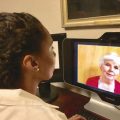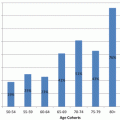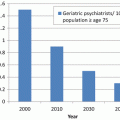As the population continues to age, more healthcare professionals will be required. Mental illness is prevalent in this population. Depression symptoms are present in up to 25% [2] and anxiety in over 50% [3] of individuals age 60 and over. An estimated 5.2 million Americans suffer from major neurocognitive disorder due to Alzheimer Disease [4] with up to 60% exhibiting associated psychiatric and behavioral symptoms [5]. These mental health disorders often require the expertise of geriatric psychiatrists. In 2010, there were approximately 1700 geriatric psychiatrists in the USA, roughly 1 per 10,000 adults age 75 and older (www.americangeriatrics.org). Geriatric telepsychiatry represents one avenue to increasing access to specialized geriatric psychiatry care.
Access to care can be a significant barrier to obtaining mental healthcare for many Americans. Access can be further limited for those individuals residing in less populated or rural areas. The United States Office of Management and Budget defines a metropolitan area as an area with a population of 50,000 or more residents. A micropolitan area consists of 10,000–50,000 residents [1]. The 2010 US Census Brief on older Americans found 3.4 million individuals age 65 and over reside in non-metropolitan or micropolitan areas, representing 17.2% of the total rural population. In comparison, older adults make up 12.8% of the metropolitan and micropolitan population [6]. Although a majority of the geriatric population resides in more populated areas, a significant number are in geographical areas that are often plagued with limited resources, and lack of access to specialized health care. This geographic distribution further highlights the need for innovative methods to improve access to care for the elderly.
Another potential barrier to mental healthcare access can be residence in a long term care facility. Of the 40.3 million individuals comprising the geriatric population in 2010, 1.3 million or 3.1% resided in skilled nursing facilities. The proportion of nursing home residents increases with age from 0.9% for individuals age 65–74 years to 10.4% for those age 85–94 [7]. As the proportion of the oldest-old continues to increase, the nursing home population is predicted to increase as well. This increase is likely to lead to increased demand for mental health care. Current estimates of the prevalence of mental health disorders in nursing home settings vary with diagnosis (Table 2.1). Data from the National Nursing Home Survey (NNHS) estimates approximately 50% of nursing home residents have a chronic mental illness or dementia [7]. Furthermore, it is estimated that up to 80% of nursing home residents with mental illness do not receive necessary mental health care compared to 58% of community dwelling older adults [7]. Geriatric telepsychiatry is one way to address this unmet healthcare need of the nursing home population.
Table 2.1
Prevalence estimates of psychiatric disorders in nursing homes
Diagnosis | Prevalence (%) |
|---|---|
Behavioral and psychological symptoms of dementia | 78 |
Neurocognitive disorder | 58 |
Anxiety symptoms | 30 |
Depressive symptoms | 29 |
Schizophreniaa | 17 |
Major depressive disorder | 10 |
Posttraumatic stress disordera | 10 |
Alcohol use disordera | 10 |
Drug use disordera | 6 |
Anxiety disordersb | 6 |
2.3 Cost Considerations
The need for increased access to mental health care for the aging population is evident. In attempting to meet this need, potential solutions must be cost effective in order to be sustainable. There are several factors that affect the cost of providing care by telepsychiatry. While economic considerations will be examined in greater detail in later chapters, a brief overview is provided here.
In order to be sustainable, the cost of providing telepsychiatric care must be offset by savings. Direct costs include cost of audiovisual conferencing hardware and software technologies, installation/setup fess, and other supply costs. (Technological requirements will be reviewed in a later chapter.) Fixed costs factor in staff salaries and wages as well as other administrative expenses. There are also variable expenses to include data transmission fees and costs associated with equipment maintenance [8]. Due to these expenses, earlier studies found telepsychiatry to be cost ineffective. In 1998, Werner et al. compared the cost of a face-to-face community mental health medication management visit to remote care. Two remote care options were examined—(1) university based telepsychiatry consultation to a rural community mental health clinic and (2) other rural site based telepsychiatry consultation to rural community mental health clinic. Results revealed two to three fold higher costs per visit for telepsychiatric care ($244/visit for other rural site based telepsychiatry visit, $179 for university based telepsychiatry visit, and $78.50 for in-person community mental health center visit) [9].
In contrast to these earlier findings, more recent studies have found that care by telepsychiatry leads to overall decrease in total costs due mainly to savings in travel costs. Compared to telepsychiatry, face-to-face psychiatric evaluations to remote sites require not only travel and accommodation expenses for the physician, but often times, higher compensation due to travel requirements. In 2007, O’Reilly et al. found that the average cost of telepsychiatric care was 10% less per patient and 16% less per visit compared to in-person care [10]. In 2010, Rabinowitz et al. examined the cost associated with 278 nursing home telepsychiatry consultations and found personnel cost savings of over $30,000 and physician savings of over $80,000 when compared to face-to-face care [11]. One potential explanation for the differences between earlier and recent findings with regard to cost is an overall decrease in cost of technology and remote communication. In fact, in 2011 Doolittle et al. found that since 1995, there has been a 70% decrease in cost per patient in providing telemedicine care. This decrease was attributed to both decreased technology costs and increased number of patient visits [12]. These figures support the notion of telepsychiatry as cost effective method of meeting the increasing mental health care demands of the growing geriatric population.
2.4 Clinical Applications of Telepsychiatry to Geriatric Mental Health Care
Telepsychiatry has the potential to increase access to specialized mental health care while decreasing costs. Equally important are its accuracy and effectiveness in providing a means by which patients can be evaluated and treated. Telepsychiatry has been applied to patients in multiple different settings to include outpatient general medical clinics, hospital emergency departments, nursing and group homes, hospice facilities, rural facilities, and forensics/correctional settings. Several models of consultative services can be employed and may vary based on the clinical setting .
- 1.
In the traditional or replacement model, the psychiatrist serves as the primary provider of mental health care with limited communication with the referring primary care provider.
- 2.
In the consultation care model, the primary care provider retains the primary role even as it pertains to mental health care but seeks consultations from the psychiatrist.
- 3.
The third model, the collaborative care model, consists of joint provision of mental health care by the primary care physician and the psychiatrist with frequent communication between both providers [13].
Furthermore, the telepsychiatry interaction can be either synchronous or asynchronous. Synchronous evaluations involve communication between the patient and the psychiatrist that occurs at the same time, typically via two-way videoconferencing , chat, or telephone. Asynchronous encounters, also known as store-and-forward, consist of the psychiatrist reviewing pre-recorded interactions between the patient and primary care provider. The psychiatrist then formulates a diagnosis, treatment plan, and provides the primary care provider with treatment recommendations. Irrespective of the clinical setting or the consultation model employed, telepsychiatry has been demonstrated to be feasible, reliable, and equivalent to face-to-face care [8].
In 2013, Conn et al. described a 7-year experience of utilizing a university based telepsychiatry program to provide consultations to six rural communities in Canada. Almost 300 patients were evaluated and treated with the most common conditions encountered being dementia, depression, and mild cognitive impairment [14]. In 2001, Johnston and Jones reported on successful utilization of telepsychiatry to provide 71 consultations to 40 rural nursing home patients age 60–95. Again, the most frequently encountered diagnoses were dementia related behavioral disturbances and depressive disorders. The authors cited increased contact with patients and staff at the rural nursing facility, improved follow through of recommendations, and elimination of psychiatrist’s travel as the major advantages of the program [15].
Geriatric telepsychiatry is not only feasible, but also diagnostically reliable . Telepsychiatry can be used to reliably diagnose various mental health disorders including mood disorders, panic disorder, and alcohol dependence [16]. Grob et al. conducted a study with residents of a Veterans Affairs nursing home examining in-person versus remote administration of three screening tools—the Mini Mental State Examination (MMSE) , Geriatric Depression Scale (GDS) , and the Brief Psychiatric Rating Scale (BPRS) . Results showed no significant differences between groups [17]. In 2004, Shores et al. found 100% agreement in initial diagnosis of dementia in residential care veterans who were assessed in-person versus by telepsychiatry [18]. Cullum et al. demonstrated that a battery of neuropsychological tests can be successfully administered to patients with cognitive impairment via videoconferencing [19]. These findings demonstrate telepsychiatry as an effective modality by which patients can be accurately assessed and diagnosed.
Furthermore, telepsychiatric care produces outcomes equivalent to in-person care. O’Reilly et al. examined reduction in Brief Symptom Inventory scores in a general adult population assessed in-person versus remotely. Outcomes were equivalent for both groups [10]. Similar results were found when comparing treatment of depressed veterans in-person versus remotely, with comparable reductions in scores on the Hamilton Depression Rating Scale and Beck Depression Inventory. In addition, there is equivalent compliance in keeping appointments and adhering to medications [20].
Another outcome of interest when telepsychiatry is employed is its potential impact on overall resource utilization. The application of telemedicine to the care of geriatric nursing home patients can allow for more patients to be served with shorter follow-up intervals [21]. This can lead to downstream effects on the healthcare system as a whole including up to 10% decrease in emergency department visits and acute hospitalizations [21]. This benefit to the healthcare system holds true for telepsychiatry as well. Lyketsos et al. found approximately 50% decrease in acute hospitalizations with overall fewer days in the hospital when geriatric nursing home patients with dementia had access to telepsychiatric assessment and treatment [22]. As the aging population continues to grow, efficient use of limited resources must remain a priority.
Stay updated, free articles. Join our Telegram channel

Full access? Get Clinical Tree






